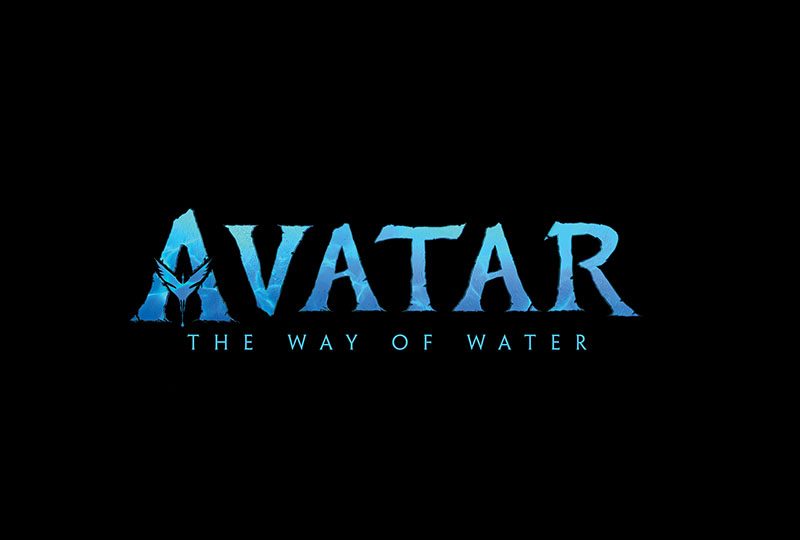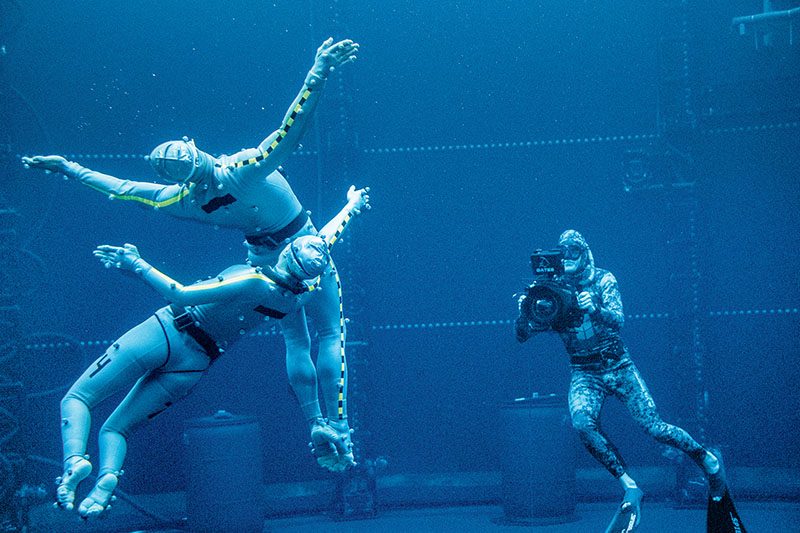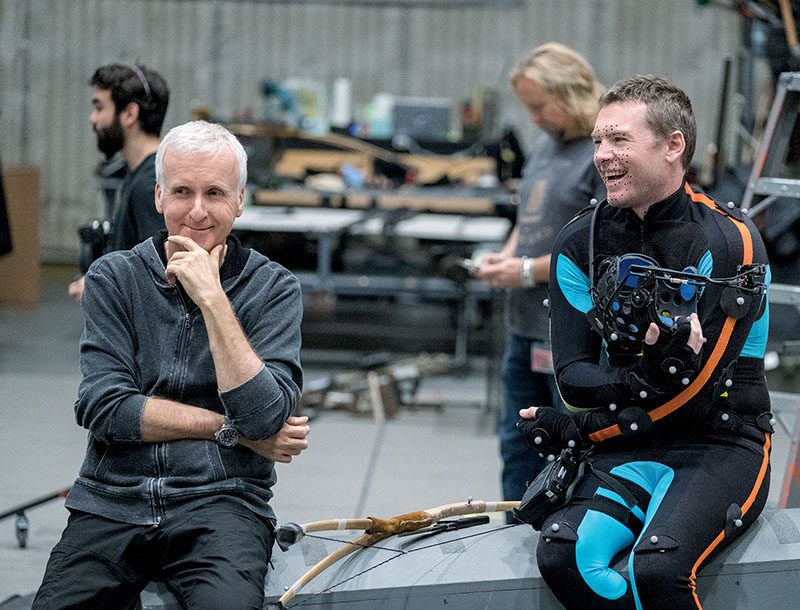Setelah dirilis pada Desember 2022, Avatar: Jalan Air menarik perhatian besar dari komunitas penyelam karena pemandangan bawah lautnya yang luar biasa. Penasaran untuk menyelami kisah di balik layar tentang apa yang diperlukan untuk mencapai penguasaan teknis yang ditampilkan dalam adegan-adegan tersebut, saya mengobrol dengan produser Jon Landau, instruktur penyelaman bebas Kirk Krack, direktur fotografi bawah air Pete Zuccarini, dan penyelam master dan petugas keselamatan John Garvin.
The sequel to 2009’s Avatar introduces the Metkayina, Na’vi who are born in the ocean and have adaptations such as tails shaped to help enhance in-water propulsion and eyes that provide better underwater vision. They move through the water much like freedivers without fins. The in-water skills the Metkayina characters demonstrate are rooted in hydrodynamics. Landau explained this quest for authenticity in greater detail.

Apa proses pemikiran yang digunakan untuk membuat film bawah air secara ekstensif?
Jon Landau: The first thought was the story. Going into the sequel, we saw the ocean as a transportive journey for our audience to go to the incredible places you’ve been to or that I’ve been lucky enough to dive, and for sure those Jim Cameron has explored. Pandora is a world with water, like Earth. Not all of this film is underwater, of course, but as we saw from the first movie’s fantastical forest and floating islands, there is also a great deal of joy and wonder in the oceans of Pandora.
Think about when you swim around a reef structure and suddenly see a manta ray or a whale shark. You’re amazed! We wanted to take what ocean life has shown us and stand it on its tail. We know from experience what a sperm whale looks like underwater, and we wanted our whale variants, the tulkun, to grow to 300 feet (91 meters) long and have amazing new functionalities and a spiritual relationship with the Metkayina. That was the kind of ocean environment we envisioned.
I saw that in your coral reef. The fish were generally similar to fish we see on Earth, as if they had some distant relation to jacks, butterflyfish, and jellyfish. We saw the basic forms of sharks, whales, eels, and even a flying fish, but clearly different. This isn’t your first splash into underwater films. Jim made The Abyss pada tahun 1989, dan Anda dan dia berkolaborasi dalam Titanic pada tahun 1997. Ada banyak pekerjaan air di sana.
Yes, but this one has something Titanic did not: breath-hold diving! When Jim approached Sigourney Weaver to do this movie, he told her she needed to be able to hold her breath for three minutes to do a scene. She said, “Jim, I can’t hold my breath for 30 seconds.” Yet eventually she could do much more than that, working her way up to five minutes of static apnea.
You’ve seen movies that are dry-for-wet; Aquaman is an example. The underwater scenes are typically simulations in front of a green screen, and performers levitate on cables to approximate what they might look like moving within an environment more than 800 times denser than air. Wind machines blow their hair, and computer-generated imagery techniques are added during postproduction. That was not good enough for Jim. He wanted the authenticity of wet-for-wet, which meant that everyone — actors and camera crew — had to be skilled freedivers.
Teknologi ini sudah cukup lama ada, sehingga para pembaca Anda mungkin tahu sesuatu tentang performance capture. Anda mungkin mengenali manik-manik bundar yang dijahit pada pakaian dalam bidikan di balik layar dari Avatar or other movies. But now the reflective marker dots would be on wetsuits, and the underwater cameras can’t really differentiate between a marker on an actor’s suit or an exhaust bubble from a scuba regulator.
As Jim explained it, “Everybody who was working in the tank was holding their breath. If there was someone down there holding a light, they were holding their breath. If they were operating a camera, they were holding their breath. The actors, of course, had to be holding their breath.” That bit of physics — the inability to differentiate between a performance-capture suit marker and an exhaust bubble — is why Avatar: Jalan Air harus menjadi film penyelaman bebas.

Pelatihan Aktor dan Kru
Untuk lebih memahami aspek penyelaman bebas dalam film ini, saya mewawancarai Kirk Krack, pendiri Performance Freediving International. Selama lima tahun terakhir, dia telah terlibat secara dekat dalam membangun protokol dan menginstruksikan para pemain dan kru untuk beroperasi pada tingkat efisiensi penahanan napas yang tinggi yang diperlukan untuk film ini.
I learned about the huge tanks you were using for filming. The tank at production company Lightstorm Entertainment’s Manhattan Beach, California, studio was 120 feet (36,6 meters) long, 60 feet (18 meters) wide, and 30 feet (9 meters) deep. It held more than 250,000 gallons (946.353 litres) of water and could simulate waves breaking on the shore. That was just one of the six tanks, so this film had significant in-water infrastructure. I understand why bubbles were an issue for the wet-to-wet film technique, but couldn’t rebreathers have worked as well?
Kirk Krack: In shallow water, rebreathers aren’t necessarily totally bubble-free. Even more important, the Metkayina have evolved for life in the sea, so they needed to move like freedivers. The underwater “volume” (the name for performance-capture stages) was a huge tank with 200 cameras mounted at three levels plus the cameras that Pete Zuccarini and the assistant camera operators were shooting. We couldn’t have some people on scuba, some on rebreathers, and some freediving. With that as the prerequisite, we had to consider what it would take to make everyone in the tank into freedivers.
I saw it as a two-pronged approach. We’d have to start with a training regimen to make the cast, crew, and camera operators into freedivers if they weren’t already, and if they were, make sure they would follow the same protocols as our new freedivers. Once we were filming, we utilized technical freediving to enhance performance capabilities. At times, people in the tank might be prebreathing 50 or 80 percent nitrox before their freedive performances. Being on the set made everyone appreciate the cutting-edge technology necessary to bring the ideas to fruition.


Saya membaca tentang teknologi ini dalam catatan produksi. Cameron mengatakan bahwa kamera virtualnya mengintegrasikan dua volume pengambilan gambar (udara dan bawah air) dalam waktu nyata.
The virtual camera was especially mind-boggling. You had all these cameras filming people with marker dots moving in a tank, yet on the topside monitor we saw them swimming in the surreal Pandoran sea in real time. It was a unique form of moviemaking. I predict the upcoming film awards season will fully recognize this film’s degree of technical achievement.
There was something special about this project. Cameron’s demands for perfection meant we had time and motivation to thoroughly train the people involved. Some of the cast and crew were water savvy, but some were almost afraid of the water. We had the luxury of concentrating on freediving theory, water safety, and technique. We had to make them such good freedivers they could go beyond merely holding their breath. They couldn’t look like they were trying to survive; they had to be able to act.
It was quite challenging for me and the stunt performers. I often did more than three hours of breath-hold diving in a 12-hour workday. At 6 a.m. I might be up vacuuming the tank, and at the end of the day we’d blend the nitrox for the next shoot day. We had up to 30 people in the water at once and logged more than 250,000 freedives on this movie. All the actors could do more than four minutes in static apnea, and Kate Winslet could do more than seven minutes!
Bagaimana cara kerjanya secara praktis? Apakah semua orang di permukaan menunggu Jim menelepon “action,” and then you all dived to shoot?
No, it was exactly the opposite. All 200 people working on the scene would be waiting on us. Our freedive performance was the linchpin. We’d count down to our signal to dive after we’d prebreathed and established comfort level for performing. We used technical freediving with nitrox to reduce hypoxia risk, recover more rapidly, and become comfortable enough with the in-water experience to act.
Membuat Film Penyelam Bebas
Ketika sebuah film Hollywood beranggaran besar membutuhkan juru kamera bawah air, Pete Zuccarini kemungkinan besar akan dipanggil untuk beraksi. Tidak mengherankan jika Zuccarini dilibatkan saat Cameron merekrut talenta terbaik untuk proyek ini. Tidak diragukan lagi, dia adalah seorang penyelam bebas yang berbakat. Meskipun pengambilan gambar untuk Avatar: The Way of Water dimulai pada bulan September 2017 dan berlangsung selama kurang lebih 18 bulan, Zuccarini bergabung dengan proyek ini pada bulan April 2017.
Khas dari persiapan yang dilakukan untuk produksi James Cameron, Zuccarini dipanggil untuk melakukan uji coba pengambilan gambar di lingkungan yang berbeda, termasuk Pelabuhan San Pedro, Pulau Catalina, dan Bahama. Di Bahama, mereka memfilmkan penyelam bebas pemecah rekor, William Trubridge, yang menyelam bebas tanpa sirip, sehingga mereka dapat mempelajari dan mempertimbangkan tekniknya.


It seems like there are scenes in the movie that someone who isn’t a diver and hadn’t seen such an interplay of light somewhere beneath the sea couldn’t have scripted. James Cameron, in particular, has apparently been diving with a different objective over the years, for I see decades of studying light underwater in every frame.
Pete Zuccarini: Interaksi cahaya pada kedalaman dan kondisi laut yang berbeda sebenarnya sudah direncanakan. Selama pengujian lautan terbuka kami di Bahama, Jim meminta saya untuk memotret elemen yang sangat spesifik dalam 8K pada frekuensi gambar yang tinggi. Kami mempelajari bagaimana cahaya disaring melalui kolom air di bawah ombak laut yang besar, permukaan berombak yang berangin, dan permukaan yang halus seperti kaca. Kami menangkap kualitas cahaya yang menyebar melalui partikel dan bagaimana pola pembiasan bermain pada substrat bentik pada kedalaman yang berbeda.
The visual effects team pretty well understood the filtering of color wavelengths at different depths, so we were going after more subtle physics details, such as the way sand was twirling off the tops of the ripples in the sand under the waves. We looked at how swell and turbulence moves things such as hair, clothing, skin, and seagrasses. These high-resolution real ocean images provided reference data to better inform and communicate with the visual effects team responsible for creating Pandora’s ocean.
Untuk merasakan pengalaman menunggangi hewan air yang besar dan kuat di lautan lepas, tim pemeran pengganti menciptakan proksi mekanis dari tulkun, ilu, dan skimwing. Makhluk-makhluk mekanis ini ditarik oleh perahu atau didukung oleh peralatan bertenaga jet untuk mensimulasikan gerakan dan kemampuan manuver makhluk yang Anda lihat dalam film.
An underwater stunt “driver” and another stunt performer would hang on rodeo-style at incredibly high speeds. The velocity of the rapid ascents and descents required the stunt team to accomplish unprecedented feats of breath-holds, equalization, and strength. Imagine riding a creature with enough inertia to go from underwater, jump 12 feet (3,6 meters) out of the water, and then descend in seconds to a depth of 40 feet (12 meters). All the while the stunt performers were doing hand signals and facial expressions to remain in character while traveling 5 knots underwater.
Jim menginginkan kamera referensi untuk merekam setiap momen dari berbagai sudut. Selain memasang kamera aksi pada makhluk dan pemeran pengganti, kami menyiapkan dua kendaraan pendorong penyelam yang sangat cepat (DPV) untuk melacak aksi tersebut. Saya beroperasi bersama-sama dengan Charlie Arneson untuk mengikuti aksi di bawah air. Kereta luncur kamera ini cukup cepat sehingga membutuhkan penutup kepala untuk menjaga agar masker selam kami tidak terlepas dari wajah kami.
Saya menggunakan penjepit hidung khusus yang memungkinkan saya untuk menyamakan telinga dan masker hands-free. Kebutuhan untuk mengikuti subjek melalui pendakian yang cepat dan untuk tetap ramping dan lincah mengharuskan kami beroperasi sebagai penyelam bebas. Dari pengujian ini, Jim menyempurnakan apa yang ingin ia lihat dalam desain dan pemanfaatan tangki penangkap performa Lightstorm yang dibuat di Manhattan Beach Studios.


Mengawasi Keselamatan
One of the most important people on this film was John Garvin, who oversaw the tens of thousands of scuba dives and hundreds of thousands of freedives over the four years of shooting. Up to 30 divers — stunt performers, grips, lighting technicians, camera operators, safety divers, and actors — could be working in the tank at any given time. The work was often spread among a dozen different dive teams in a rapidly changing environment. No one got hurt on the production, which says a lot about Garvin’s professionalism and commitment.
Apa yang harus Anda lakukan terdengar seperti tantangan yang menakutkan. Bagaimana Anda melakukannya?
John Garvin: Tugas pertama saya adalah menulis manual operasi keselamatan penyelaman kami. Kami harus mendefinisikan bahaya dan memitigasinya. Departemen pencahayaan harus bergerak naik dan turun melalui kolom air, jadi kami mengadaptasi Tasmanian Bounce Diving Tables untuk campuran nitrox kami. Kami memiliki komputer selam di setiap pergelangan tangan, dan meskipun penyakit dekompresi bukanlah kekhawatiran pertama kami, namun hal itu dapat terjadi jika menghabiskan waktu hingga 12 jam sehari di dalam air. Setiap tangki produksi memiliki latihan darurat khusus berdasarkan karakteristiknya.
Kami juga berkonsultasi dengan para ahli terbaik di bidang spesialisasi mereka, seperti Neal Pollock, PhD, dan Simon Mitchell, MB ChB, PhD. Prinsip lain dari pendekatan kami adalah belajar dari kesalahan-kesalahan kami selama ini. Kami tidak pernah mengalami pemadaman di perairan dangkal, namun kami sempat kehilangan kendali motor di permukaan pada awal proses. Kejadian itu memberi tahu kami bahwa nitrox prebreathing diperlukan. Target awal kami adalah menahan napas selama dua menit untuk setiap aktor, dan kami berhasil melampauinya. Metkayina lahir di dalam air, jadi tujuan penting lainnya adalah agar semua aktor terlihat nyaman di dalam air, seolah-olah mereka juga terlahir di dalam air.
Apakah ada bahaya tangki tertentu yang membuat Anda terjaga di malam hari, bertanya-tanya bagaimana cara mengatasinya?
Bola-bola difusi yang mengapung di permukaan membuat saya sangat cemas. Meskipun ukurannya sempurna untuk transmisi cahaya dan memungkinkan penyelam untuk menembus udara, bola-bola itu juga berukuran trakea yang sempurna. Penyelam tidak hanya harus naik ke permukaan, tetapi mereka juga harus mengangkat kepala mereka melalui selimut bola-bola berukuran 3 inci (7,6 sentimeter) untuk mengambil napas. Kami menyiapkan protokol keselamatan jika terjadi tertelan. Untuk semua inovasi teknologi tinggi pada film ini, mie kolam $2 untuk para aktor beristirahat di permukaan adalah hal yang sangat kami andalkan.
How did you communicate underwater? I can’t imagine hand signals were enough for a project this complex.
I give a huge shoutout to Ocean Technology Systems. The set was quite noisy underwater, yet everyone had to follow their team’s directions. That meant operating on different channels with multiple hydrophones and noise gates. The grips had to constantly talk to each other to do their job, for example, but the actors needed to hear Jim.
His communication with the actors was invaluable because Jim is a tremendously experienced diver. He knows that water dictates movement. You can’t fake that. Even nondivers in the audience will intuitively pick up on underwater physicality that isn’t right for some reason, which then severs the emotional attachment. That’s why this film is wet-for-wet. We hope it will resonate with anyone who deeply loves the ocean, but it will be particularly relatable to divers.
We did everything underwater that you see underwater in this film. The team came to understand the technical challenges of bringing James Cameron’s vision of underwater Pandora to life. Yet, as Landau pointed out, while the ocean provided the backdrop to tell the story, the story was still paramount. Our job was to collaborate with Jim, the entire crew, and the actors to bring the underwater visuals of that story to life.
Jelajahi Lebih Lanjut
Pelajari lebih lanjut tentang pembuatan Avatar: Jalan Air dalam video ini.
© Penyelam Siaga - Q1 2023